RBSE Solutions for Class 10 Science Chapter 10 Electricity Current are part of RBSE Solutions for Class 10 Science. Here we have given Rajasthan Board RBSE Class 10 Science Solutions Chapter 10 Electricity Current.
| Board | RBSE |
| Textbook | SIERT, Rajasthan |
| Class | Class 10 |
| Subject | Science |
| Chapter | Chapter 10 |
| Chapter Name | Electricity Current |
| Number of Questions Solved | 125 |
| Category | RBSE Solutions |
Rajasthan Board RBSE Class 10 Science Solutions Chapter 10 Electricity Current
Textbook Questions Solved
I. Multiple Choice Questions
RBSE Class 10 Science Chapter 10 Question 1:
If a 5 V battery is providing 2 A current in a conductor then what is the resistance of conductor?
(a) 3 Ohm
(b) 2.5 Ohm
(c) 10 Ohm
(d) 2 Ohm
Answer:
(b) 2.5 Ohm
RBSE 10 Science Solution Question 2:
Resistivity depends on which of the following?
(a) Length of conductor
(b) Transverse section of conductor
(c) Material of conductor
(d) None of these
Answer:
(c) Material of conductor
Electric Current Class 10 Question 3:
Volt is the unit of which of the following?
(a) Current
(b) Potential difference
(c) Charge
(d) Work
Answer:
(b) Potential difference
Electricity Class 10 Questions And Answers Question 4:
Three conductors of resistance 1Ω, 2Ω and 3Ω are in series in a circuit. What is the equivalent resistance in the circuit?
(a) Less than 1 Ω
(b) Less than 3 Ω
(c) More than 1 Ω
(d) More than 3 Ω
Answer:
(d) More than 3 Ω
Electricity Numericals Class 10 Question 5:
What is the frequency of AC in India?
(a) 45 Hz
(b) 50 Hz
(c) 55 Hz
(d) 60 Hz
Answer:
(b) 50 Hz
RBSE Solution Class 10 Science Question 6:
What happens in each resistor when resistor of different values in parallel combination are connected to a source of electricity?
(a) Values of current and potential difference are different
(b) Values of current and potential difference are same
(c) Values of current are different but value of potential difference is same
(d) Value of current is same but values of potential difference are different
Answer:
(c) Values of current are different but value of potential difference is same
Electricity Class 10 Question 7:
If 2 Coulomb charge flows for 0.5 second in a circuit then what is the value of electric current?
(a) 1 A
(b) 4 A
(c) 1.5 A
(d) 10 A
Answer:
(b) 4 A
RBSE Solution Science Class 10 Question 8:
Which of the following does not work on heating effect of electric current?
(a) Heater
(b) Electric iron
(c) Toaster
(d) Refrigerator
Answer:
(d) Refrigerator
Electricity Current Very Short Answer Type Questions
Science Class 10 RBSE Solutions Question 9:
What is the unit of specific resistance or resistivity?
Answer:
Ohm metre
RBSE Solutions 10 Science Question 10:
Define electric current.
Answer:
Flow of electric charge is called electric current.
RBSE Solution Of Science Class 10 Question 11:
What is electric potential?
Answer:
An electric potential (also called the electric field potential or the electrostatic potential) is the amount of electric potential energy that a unitary point electric charge would have if located at any point in space.
Science Chapter 10 Class 10 Question 12:
How will you define 1 Ω resistance?
Answer:
If 1 A of electric current through a conductor produces 1 V of potential difference between its two ends then resistance of conductor is 1 Ω .
RBSE Solutions Class 10 Science Question 13:
How does resistance depend on transverse section?
Answer:
Resistance varies inversely as area of cross section.
Class 10 RBSE Solutions Science Question 14:
Define resistivity.
Answer:
The resistance of a wire of unit length and unit area of cross-section is called resistivity.
10th Class RBSE Solution Science Question 15:
What is electric power?
Answer:
Work done by electric current in unit time is called electric power.
RBSE Solutions Science Class 10 Question 16:
100W – 220V is written on an electric bulb. What does it mean?
Answer:
100 W shows the power of bulb, while 220 V shows the maximum potential difference required for proper functioning of bulb.
Class 10 RBSE Solution Science Question 17:
Which type of combination of resistors is seen in household wiring?
Answer:
Parallel combination
Electricity Current Short Answer Type Questions
RBSE Solutions For Class 10 Science Question 18:
What is the difference between series and parallel combinations of resistors?
Answer:
| Series combination | Parallel combination |
| Resistors are combined in a way that one end of a resistor is connected to next end of another resistor. Ends of each resistor are in direct contact with source of electric current. | Ends of each resistor are not in direct connection with source of electric current. |
| Equivalent resistance is more than individual resistances. | Equivalent resistance is less than individual resistances. |
RBSE Class 10 Science Chapter 12 Question 19:
What is electric power? Write its formula.
Answer:
Work done by electric current in unit time is called electric power.
P = \(\frac { w }{ t }\)
Here, P is power, W is work done and t is time.
RBSE Class 10 Science Chapter 10 Notes Question 20:
Two resistance wires are made up of same material and have same length. If ratio of areas of cross section is 2:11 then what is the ratio of their resistance?
Answer:
We know that;
R = K x \(\frac { 1 }{ A }\)
If R1 and R2 are resistance of two wires and and A2 are their areas of cross section then,
\(\frac { { R }_{ 1 } }{ { R }_{ 2 } }\) = \(\frac { l }{ { A }_{ 1 } }\) +\(\frac { l }{ { A }_{ 2 } }\)
\(\frac { { A }_{ 2 } }{ { A }_{ 1 } }\) = \(\frac { 11 }{ 2 }\)
RBSE Class 10 Science Solution Question 21:
Define electric potential and potential difference.
Answer:
An electric potential (also called the electric field potential or the electrostatic potential) is the amount of electric potential energy that a unitary point electric charge would have if located at any point in space.
Potential Difference: Difference in electric potential between two points in a circuit is called potential difference.
Class 10 Science Chapter 10 Question 22:
What is the difference between AC generator and DC generator?
Answer:
| AC Generator | DC Generator |
| Current flows alternately in both directions. | Current flows in only one direction. |
| Circular rings are present | Split rings are present as commutator. |
Class 10th RBSE Solution Science Question 23:
Write the Right Hand Rule.
Answer:
Right Hand Rule: If thumb of right hand is kept straight and all other fingers are wrapped around, then thumb shows the direction of current and direction of fingers shows the direction of magnetic field.
Class 10 Electric Current Question 24:
Find the number of joule in 1 kilo watt hour.
Answer:
1 Kilowatt Hour = 1000 x 60 x 60 watt x second
= 1000 x 3600 x (joule/second) x second
= 105 x 36 joule
Class 10 Science Chapter 10 Solutions Question 25:
Write Joule’s law of heating.
Answer:
The heat produced in a conductor is given as follows:
H = I2Rt
Here, I = current, R = resistance and t = time
This equation shows Joule’s law of heating which says that heat varies directly proportional to square of current, resistance and time..
Class 10 Science Chapter 10 Question Answer Question 26:
Make a diagram of experimental verification of Ohm’s
Answer:
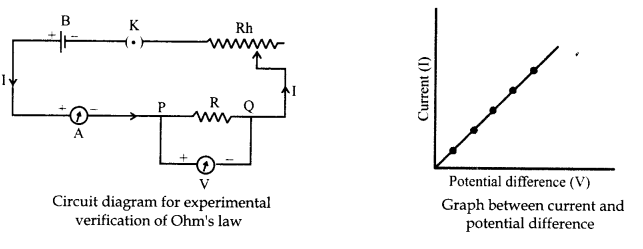
Electricity Current Long Answer Type Questions
Science Chapter 10 Question 27:
Explain the structure and working of AC generator with the help of a suitable diagram.
Answer:
Construction: There are four main parts in an AC generator, viz. field magnet, armature, slip ring and brushes.
- Field Magnet: This is a very powerful magnet; as shown by NS in given figure.
- Armature: This is composed of a rectangular coil ABCD which has insulated copper wire wound around a frame of cast iron.
- Slip Ring: Two metallic rings S1 and S2 are connected respectively to the ends A and D of coil. These rings rotate along with rotation of coil.
- Brushes: These are made of carbon or any metal. One end of brushes touches the slip ring while another end touches other part of the circuit.
Working of AC Generator:
When armature moves then magnetic flux through ABCD changes continuously. This induces current at the ends of the coil. When coil is rotated clockwise then the plane of coil keeps on alternatively becoming perpendicular and parallel to the magnetic field.
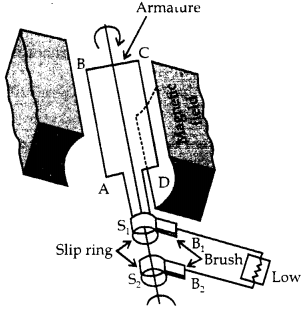
As magnetic flux reduces in first half cycle, the direction of current is clockwise in external circuit during the first half cycle. This means that during the first half cycle, current moves from B1 to B2. In the next half cycle, current moves from B2 to B1 Thus, direction of current keeps on changing after every half cycle of the armature. “When direction of current keeps on changing, it is called alternating current or AC Current.”
Question 28:
With the help of suitable diagram derive equivalent resistance of resistors in parallel combination.
Answer:
Let us make a circuit as shown in the figure.
There are three resistors R1, R2 and R3 in series combination. Current I is flowing through the circuit. The potential difference between A and B is V1, between B and C is V2 and between C and D is V3.
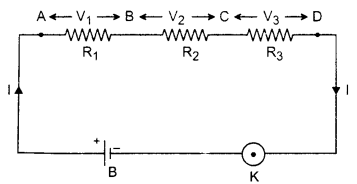
According to ohms law
V1 = IR1
V2 = IR2
V3 = IR3
If V is the potential difference in battery, then
V =V1+V2+V3
Or V= IR1 + IR2 + IR3
Or V= I(R1 + R2 + R3)
If R is the equivalent though the circuit then;
V = IR
From above equations, it is clear that
R = R1 + R2 + R3
Question 29:
With the help of suitable diagram derive equivalent resistance of resistors in parallel combination.
Answer:
Let us make a circuit as shown in following diagram. Let us assume that three resistors R1, R2 and R3 are in parallel combination. Currents I1, I2 and I3 are flowing respectively through R1, R2 and R3. Potential difference in the circuit is V and current through the circuit is I.
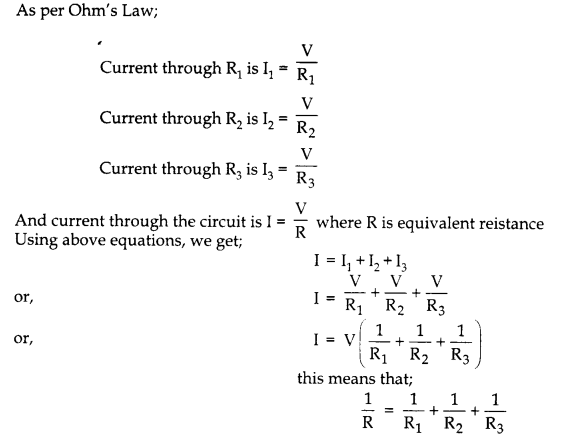
Electricity Current Numerical Questions
Question 30:
Find the maximum and minimum resistance by combination of three resistors of 1Ω, 2Ω and 3Ω.
Answer:
Maximum resistance can be obtained by series combination and minimum resistance can be obtained by parallel combination.
For series combination; equivalent resistance:
R = R1 + R2 + R3
= 1 + 2 + 3 = 6Ω
For parallel combination; equivalent resistance:
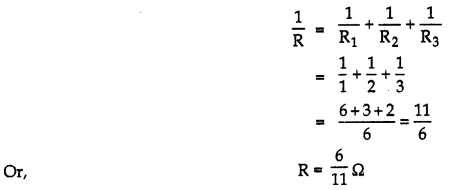
Question 31:
If 10 milliampere current flows through a wire produces a potential difference of 2.5 V between its ends, then find the resistance of wire.
Answer:
Here, I = 10 milliampere, V = 2.5 V
Using Ohm’s law;
R = \(\frac { V }{ I }\)
= \(\frac { 2.5V }{ 0.01A }\) = 250Ω
Question 32:
Find the equivalent resistanresistance between A and B in following circuits.
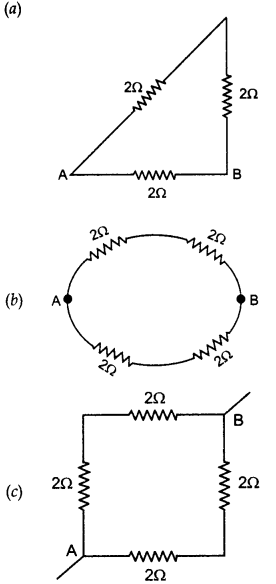

Answer:
(a) R1, R2 and R3 = 2Ω
Here; two resistors are in series and third resistor is in parallel to this group:
Equivalent resistance of two resistors in series:
R12 = R1 + R2 = 2 + 2 = 4Ω
Equivalent resistance in parallel:
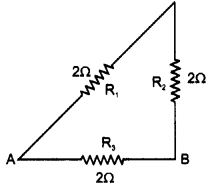
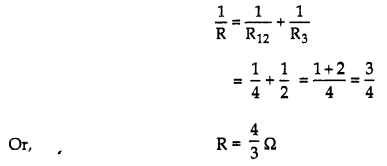
(b) Here two groups of two resistors (each in series combination) are attached in parallel combination:
Equivalent resistance in series combination:
R12 = R1 + R2= 2 + 2 = 4Ω
R34 = R3 + R4 = 2 + 2 = 4Ω
Equivalent resistance in parallel combination:
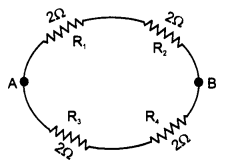

(c) Here two groups of two resistors (each in series combination) are attached in parallel combination:
Equivalent resistance in series combination:
R12 = R1 + R2 = 2 + 2 = 4Ω
R34 = R3 + R4 = 2 + 2 = 4Ω
Equivalent resistance in series combination:
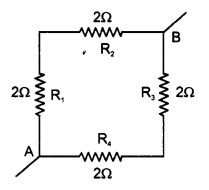

(d) Here, there are three groups of resistors in series. Two groups have three resistors in parallel combination.
Equivalent resistance in group of resistors in LHS (Parallel combination):
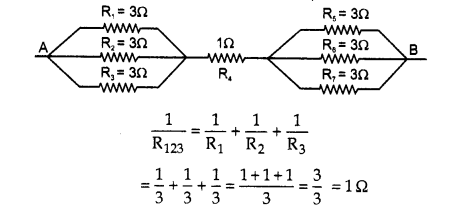
Equivalent resistance in group of resistors in RHS (Parallel combination) is same as in LHS = R567 = 1Ω
Now, equivalent resistance for overall series combination:
Question 33:
An immersion rod of 1500 W is used 3 hours per day for heating water. Find the electricity bill for 30 days if price of 1 unit is Rs. 5.00.
Answer:
Power of immersion rod = 1500 W = 1.5 kW
time per day = 3 hours, no. of days = 30
Consumption of power in 30 days:
1.5 kW x 3h x 30 = 135 kWh = 135 unit
Cost = 135 x 5 = Rs. 675
Electricity Current Additional Questions Solved
I. Multiple Choice Questions
Question 1:
The unit of specific resistance is
(a) Ohm
(b) Ohm per second
(c) Ohm meter
(d) Ohm per meter
Answer:
(c) Ohm meter
Question 2:
The resistance of germanium
with rise in temperature
(a) increase
(b) decreases
(c) remains same
(d) first increases then decreases
Answer:
(b) decreases
Question 3:
If a wire of resistance R is melted and recast into half of its length, the new resistance of wire will be
(a) R/4
(b) R/2
(c) R
(d) 2R
Answer:
(a) R/4
Question 4:
If R1 and R2 are the resistance of filaments of a 400 W and 200 W lamp designed to operate at same voltage then:
(a) R1 = 2R2
(b) R2 = 2R1
(C)R2 = 4R1
(d) R1 = R2
Answer:
(b) R2 = 2R1
Question 5:
An electric bulb is rated 220 V -100 W. If it is operated at 110 V then power consumed by it will be
(a) 100 W
(b) 50 W
(c) 25 W
(d) 400 W
Answer:
(c) 25 W
Question 6:
Electric potential is
(a) Scalar quantity
(b) Vector quantity
(c) Neither scalar nor vector
(d) Sometimes scalar sometimes vector
Answer:
(a) Scalar quantity
Question 7:
A current of 2 A passes through a conductor and produces 80 joules of heat in 10 seconds. The resistance of the conductor is
(a) 0.5 Ω
(b) 2 Ω
(c) 4 Ω
(d) 20 Ω
Answer:
(b) 2 Ω
Question 8:
A house is fitted with 10 tubes each of 40 W. If all tubes are lighted for 10 hours and if the cost of one unit of electricity energy is ₹2.50 the total cost of electricity consumption is
(a) ₹100
(b) ₹20
(c) ₹25
(d) ₹10
Answer:
(d) ₹10
Question 9:
Ohm’s law is valid only when
(a) Temperature increases
(b) Temperature decreases
(c) Current remains constant
(d) Temperature remains constant.
Answer:
(d) Temperature remains constant.
Question 10:
For metallic conductor voltage verses current graph is shown at two different temperatures T1 and T2. From the graph it follows:
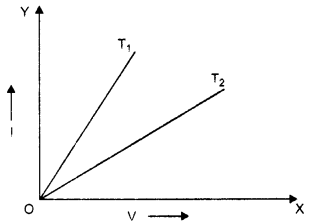
(a) T1 = T2
(b) T1 > T2
(c) T1 < T2
(d) None of these
Answer:
(c) T1
Question 11:
Seven identical lamps of resistance 220 Ω each are connected to a 220 V line as shown in figure. Then reading of ammeter will be


Answer:
(d) None of these
Question 12:
Number of kilowatt hours = \(\frac { Volt x ampere x ………….. }{ 1000 }\)
(a) Time in seconds
(b) Time in minutes
(c) Time in hours
(d) Time in davs
Answer:
(c) Time in hours
Question 13:
A man has five resistors each of 1/5 Ω. What is the maximum resistance he can obtain by connecting them?
(a) 1 Ω
(b) 5 Ω
(c) \(\frac { 1 }{ 2 }\) Ω
(d) \(\frac { 2 }{ 5 }\) Ω
Answer:
(a) 1 Ω
Question 14:
1 kilowatt hour (kWh) is equal to
(a) 3.6 x 106 MJ
(b) 3.6 x 105 MJ
(c) 3.6 x 102 MJ
(d) 3.6 MJ
Answer:
(d) 3.6 MJ
Question 15:
Kilowatt hour is unit of
(a) Energy
(b) Power
(c) Impulse
(d) Force
Answer:
(a) Energy
Question 16:
Conventionally the direction of the current is taken as
(a) Direction of flow of -ve charge
(b) The direction of flow of atoms
(c) The direction of flow of molecules
(d) The direction of flow of +ve charge
Answer:
(d) The direction of flow of +ve charge
Question 17:
The resistance of a conductor is reduced to half its initial value. In doing so the heating effects in the conductor will become
(A) half
(b) double
(c) one fourth
(d) four times
Answer:
(a) half
Question 18:
Materials which allow larger current to flow through them are called
(a) Insulators
(b) Conductors
(c) Semiconductors
(d) Alloy
Answer:
(b) Conductors
Question 19:
The resistivity of a wire
(a) varies with its length
(b) varies with its mass
(c) varies with its cross section
(d) is independent of length, cross section and mass of wire
Answer:
(d) is independent of length, cross section and mass of wire
Question 20:
What sets electron into motion in an electric circuit?
(a) Battery/cell
(b) Resistor
(c) Rheostat
(d) Ammeter
Answer:
(a) Battery/cell
Question 21:
An electric geyser has rating 2000 W, 220 V on it. What is the minimum setting of fuse wire that may be required for use with this geyser?
(a) 5 A
(b) 10 A
(c) 15 A
(d) 20 A
Answer:
(b) 10 A
Question 22:
Graphs between electric current and potential difference across two conductors A and B are shown in the figure. Which of the following conductor has more resistance?
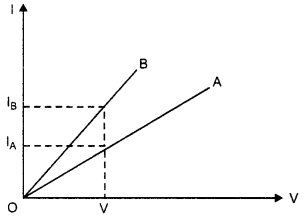
(a) B
(b) A
(c) Both have equal resistance
(d) Can’t be predicted
Answer:
(b) A
Question 23:
Two wires A and B of same metal are connected in parallel. Wire A has length and radius V and wire B has a length ‘2l’ and radius ‘2r’. Then the ratio of total resistance of parallel combination and the resistance of wire A is
(a) 1: 2
(b) 1: 3
(c) 1: 4
(d) 1: 5
Answer:
(b) 1: 3
Question 24:
Correct formula for Joules law of heating is
(a) H = I2RT
(b) H = IVT
(c) H = \(\frac { { V }^{ 2 } }{ 2 }\)
(d) All of these
Answer:
(d) All of these
Question 25:
In household electric circuit different appliances are connected in parallel to each other because
(a) The appliances work at same voltage
(b) The appliances can be operated independent of each other
(c) Even if a component of a electric circuit fails other can work efficiently
(d) All of the above
Answer:
(d) All of the above
Question 26:
The condition necessary for electromagnetic induction is that
(a) there must be a relative motion between the coil of wire and galvanometer.
(b) there must be a relative motion between the coil of wire and a magnet.
(c) there must be a relative motion between the galvanometer and a magnet
(d) all of the above.
Answer:
(b) there must be a relative motion between the coil of wire and a magnet
Electricity Current Very Short Answer Type Questions
Question 1:
What is the S.I. unit of charge?
Answer:
Coulomb.
Question 2:
Give the S.I. unit of electric current.
Answer:
Ampere (A).
Question 3:
What is the S.I. unit of electric potential?
Answer:
Volt.
Question 4:
Give the unit of electric resistance.
Answer:
Ohm (Ω)
Question 5:
How is resistance, volt and current (I) related?
Answer:
R= \(\frac { V }{ I }\) ,V = IR
Question 6:
How is 1 ohm related to ampere and volt?
Ans.
1 ohm = \(\frac { 1 Volt }{ 1 ampere }\)
Question 7:
What constitutes the current?
Answer:
Flow of free electrons constitute the current.
Question 8:
When the given resistances are connected in series, which physical quantity does not change.
Answer:
Current.
Question 9:
What is an ammeter?
Answer:
A measuring instrument used to measure electric current.
Question 10:
What is a voltmeter?
Answer:
A measuring instrument used to measure potential difference between two points in an electric circuit.
Question 11:
Give the unit of power.
Answer:
Watt.
Question 12:
How is power related to current and voltage?
Answer:
Power = V x I
Power (P) = Potential difference (V) x Current (I)
Question 13:
How is ammeter and voltmeter connected in a circuit?
Answer:
Ammeter is connected in series and voltmeter is connected in parallel.
Question 14:
What happens to the resistance when length of conductor is doubled without affecting the thickness of conductor?
Answer:
Resistance is doubled because it is directly proportional to length.
Question 15:
What is the S.I. unit of resistivity?
Answer:
Ohm meter.
Question 16:
Find the total resistance in the given circuit.
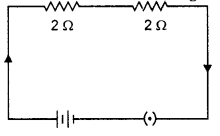
Answer:
Two resistances are connected in series, the effective resistance is 2 + 2 = 4 Ω
Question 17:
The combined resistance in the given circuit is 5 Ω. What is the value of R?
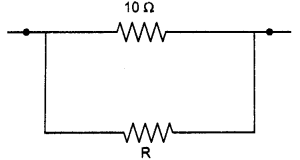
Answer:
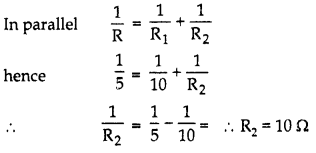
Question 18:
A wire of resistance 4 Ω is bent in the form of a closed circle. What is the resistance between the two points at the ends of any diameter of the circle?
Answer:
Between two points A and B, the resistance is divided into two semicircular parts each having resistance 2 Ω. Being in parallel connection, total resistance will be
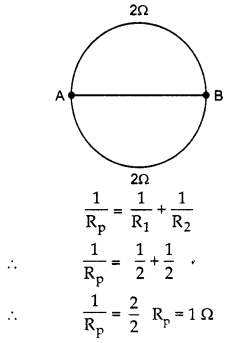
Question 19:
Define magnetic field.
Answer:
The region around a magnet in which the force of attraction or repulsion produced by the magnet can be detected is magnetic field.
Question 20:
On which factors do the magnetic field due to current carrying conductor depend?
Answer:
The magnitude of the magnetic field produced at the given point:
- Increases as the current through wire increases.
- Decreases as the distance from the wire increases.
Question 21:
Name and state the rule used to determine the direction of field in a current carrying straight conductor.
Answer:
Rule is – Right hand thumb rule.
Question 22:
Draw the magnetic field lines due to current through circular loop.
Answer:
Magnetic lines of force are circular near the wire became parallel at the middle point of the coil.
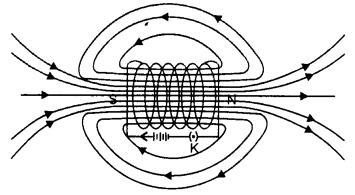
Question 23:
What is an electromagnet?
Answer:
A magnet formed temporarily due to the magnetic field of a current is called an electromagnet.
Question 24:
Name some devices that use current carrying conductors and magnetic field.
Answer:
Electric motor, electric generator, loud speaker and measuring instruments.
Question 25:
Define electromagnetic induction.
Answer:
The phenomena of inducing an electric current in a coil by changing magnetic field around it is called electromagnetic induction.
Question 26:
What is electric generator?
Answer:
It is a device that converts mechanical energy into electrical energy.
Question 27:
What is the difference between AC generator and DC generator?
Answer:
AC generator produces current which changes its direction after equal intervals of time and DC generator produces current which is unidirectional.
Question 28:
Will current carrying wire experience a force when kept parallel to the magnetic field?
Answer:
No.
Electricity Current Short Answer Type Questions
Question 1:
Give two points of difference between ammeter and voltmeter and show their arrangement in an electric circuit.
Answer:
| Ammeter | Voltmeter |
| Ammeter is an instrument used to measure current in a circuit. | Voltmeter is used to measure potential difference between two points. |
| It is connected in series in a circuit. | It is connected in parallel to the circuit. |
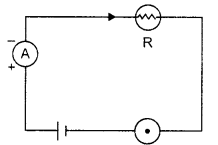 |
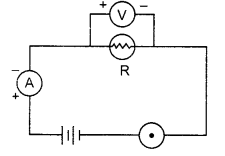 |
Question 2:
Give two points of difference between resistance and resistivity.
Answer:
| Resistance | Resistivity |
| 1. It is the property of a conductor to resist the flow of charges through it. | It is the resistance per unit length of a a unit cross section of the material. |
| 2. Its unit is ohm (Ω). | Its unit is ohm metre (Ωm). |
|
3. Resistance depends on length, crosssectional area of the wire, and material medium that depends on its temperature. |
Resistivity is the constant value for a conductor only at a given temperature. It varies with temperature. P α T. |
Question 3:
Give the differences between series and parallel connections of resistors.
Answer:
| Series connection | Parallel connection |
| 1. The potential difference (V) across the combination of resistors connected in series is equal to the sum of all the individual p.d. | The potential difference across all the resistors in parallel connection remains constant/same. |
2. Current (I) remains the same.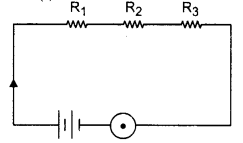 |
Current (I) will be different for different resistor.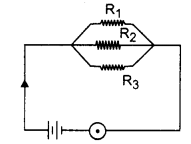 |
| 3. Total resistance will be the sum of all the resistors in the circuit. R2 = R1 + R2 + R3 | Total resistance will be given as |
| 4. Equivalent resistance is high. | Equivalent resistance is less than each resistor. |
Question 4:
Why are fairy decorative lights always connected in parallel?
Answer:
When the fairy lights are connected in series the (total equivalent) resistance offered will be greater and the brightness of the bulbs will be affected.
But in parallel connection all the bulbs will glow with same intensity and if any one bulb gets fused the other bulbs will continue to glow.
Question 5:
What is purely resistive electric circuit?
Answer:
The purely resistive electric circuit is the one in which resistor is connected to battery such that the source energy gets dissipated entirely in the form of heat.
Question 6:
Give the difference in unit of electric energy and commercial unit of electric energy.
Answer:
The unit for electric energy is watt hour i.e., Joules. For commercial unit of electric energy we use kilowatt hour.
Question 7:
Define one watt hour and one kilowatt hour.
Answer:
One watt hour is the energy consumed when 1 watt of power is used for 1 hour. One kilo watt hour is the energy consumed when 1 kilo watt (1000 watts) of power is used for 1 hour.
Question 8:
Give two disadvantages of the heating effect of current.
Answer:
The current when flows through any conductor produces heating effect. This heat produced cannot be utilized at all the places, rather it damages the circuits causing high temperature and melting of other materials can cause damage.
To keep the temperature low and cool the circuit, fans are set up e.g. In computers, fans are inbuilt to keep the components cool.
Question 9:
Give two advantages of heating effect of electric current.
Answer:
Heating effect of electric current has man room heaters, here the electric energy is deliberately made to get converted into heat energy.
Question 10:
Name the factors on which Joule’s law of heating depends.
Answer:
Joule’s law of heating depends on the following:
H α I2 RT
(i) the heat produced in a resistor is directly proportional to the square of current for a given resistance.
(ii) the heat produced in a resistor is directly proportional to the resistance for a given current and
(iii) the heat produced in a resistor is directly proportional to the time for which the current flows through the resistor.
Question 11:
What do thd following symbols represent in the electric circuit?

Answer:
The symbols used in the circuit diagram are named as:

Question 12:
What is potential difference? Explain and give its unit with definition.
Answer:
P.d.(V) between two points = \(\frac { work done (w) }{ charge(Q) }\)
= \(\frac { w }{ Q }\)
The S.I. unit of electric potential difference is volt (V).
1 volt is defined as when 1 Joule of work is done in moving a charge of 1 coulomb from one point to another.
1 volt= \(\frac { 1 Joule }{ 1 Colulomb }\)
1 V = \(\frac { 1 J }{ 1 C }\)
Question 13:
A circuit diagram is given below.
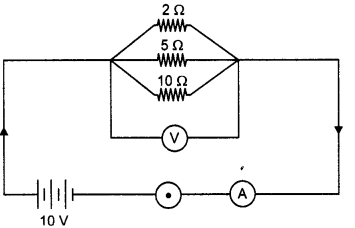
Calculate
(a) Current through each resistor.
(b) The total current in the circuit.
(c) The total effective resistance of the
Answer:
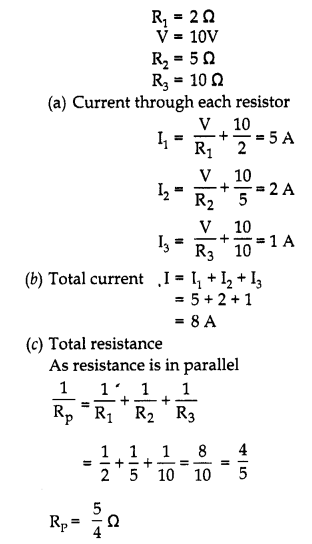
Question 14:
You are given 3 resistors each of 3 ohm and you are asked to get all possible values of resistance when you connect them in different combinations. How many values of resistance can you get?
Answer:
(i) When connected in series
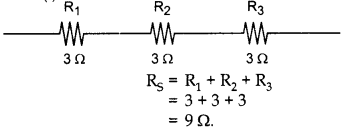
(ii) When connected in parallel
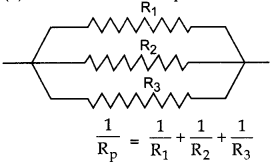
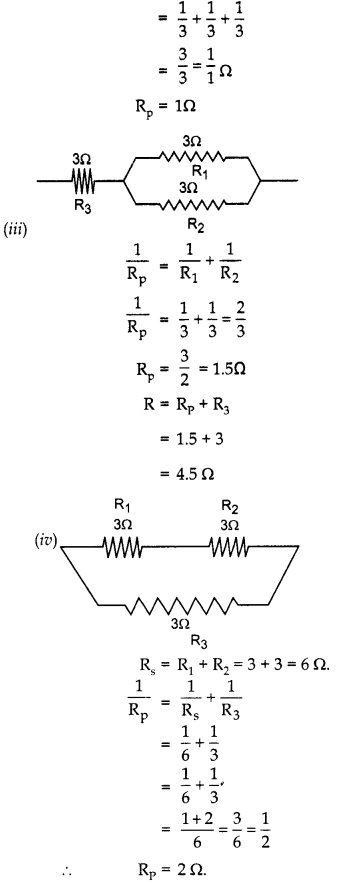
Question 15:
A battery of 10 V is connected in a circuit with 3Ω, 4 Ω, 6 Ω resistors connected in series. How much current will flow through 6 Ω resistor?
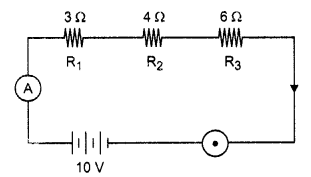
Answer:
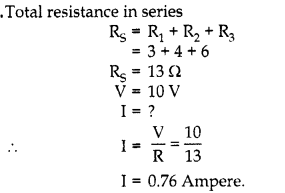
The current flowing through each resistor is same i.e. 0.76 A.
Question 16:
Two electric bulbs are rated 60 W, 220 V and 20 W, 220 V, are connected in parallel to a 220 V supply. Calculate the total electric current in the circuit.
Answer:
Given
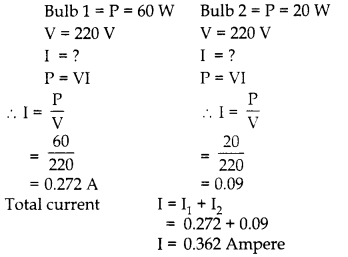
Question 17:
An electric lamp draws a current of 0.3 ampere and is used for 6 hours everyday for a month (30 days). Calculate the amount of charge that flows through the circuit everyday and for a month.
Answer:
I = 0.3 A
T =6 hours = 6 x 60 x 60 seconds
charge Q = It
charge per day = 0.3 x 6 x 60 x 60
= 6480 C
Charge flowing for a month = 6480 x 30 = 194400 C
Question 18:
What is the heating effect of electric current? Find the expression for calculating ‘Heat’.
Answer:
When current passes through the wire conductor, the temperature of the conductor increases and heat is emitted. This is called the heating effect of electric current. Consider a current I flowing through a resistor of a resistance R. Let the potential difference across it be V. Let’t’ be the time during which a charge Q flows across the resistor.
The work done in moving charge Q from one point to another through a potential difference V is VQ. Therefore the source must supply energy which is equal to VQ in time t.
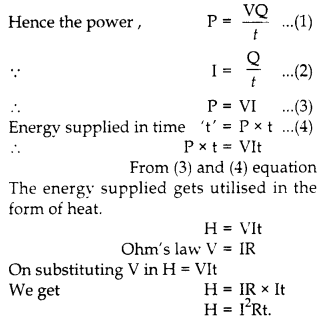
Question 19:
Two wires of equal lengths, one of copper and the other of manganin (an alloy) have the same thickness. Which dne can be used for:
(i) electrical transmission lines,
(ii) electrical heating devices? Why?
Answer:
(i) Copper is used as electrical transmission lines as it has lesser resistivity.
(ii) Manganin is used for electrical heating device as it has the comparatively higher resistivity, less oxidation and variation with temperature.
Question 20:
The following table gives the value of electrical resitivity of same materials:
| Material | Copper | Silver | An alloy |
| Electrical resistivity (in Ω) | 1.6 x 10-8 | 1.6 x 10-8 | 49 x 10-8 |
Which one is the best conductor of electricity out of them?
Answer:
Silver and copper with less resistivity is the best conductor of electricity.
Question 21:
Study the following circuit and answer the questions that follows:
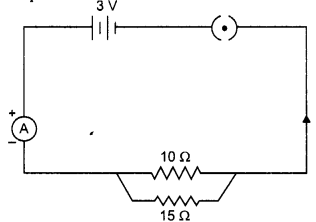
(a) State the type of combination of the two resistors in the circuit.
(b) How much current is flowing through
(i) 10 Ω and
(ii) 15 Ω resistor?
(c) What is the ammeter reading?
Answer:
(a) Two resistors are in parallel combination.
(b) Current through
(i) 10 Ω → I = \(\frac { V }{ R }\) = \(\frac { 3 }{ 10 }\) = 0.3A
(ii) 15 Ω → I = \(\frac { V }{ R }\) = \(\frac { 3 }{ 15 }\) = 0.2A
(c) Ammeter reading = Total current flowing through the circuit = 0.5 A.
Question 22:
A wire is 1.0 m long, 0.2 mm in diameter and has a resistance of 10 Ω. Calculate the resistivity of its material.
Answer:
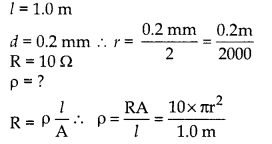
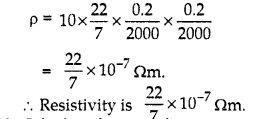
Question 23:
Calculate the areaof cross section of a wire of length 1.0 m, its resistance is 23 Ω and the resistivity of the material of the wire is 1.84 x 10-6 Qm.
Answer:
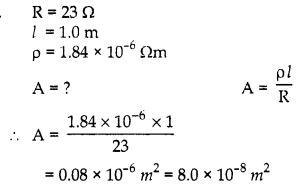
Question 24:
Draw a schematic diagram of an electric circuit consisting of a battery of two cells each of 1.5 V, 5 Ω, 10 Ω and 15 Ω resistor and a plug key, all connected in series.
Answer:
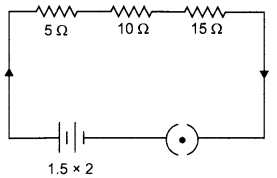
Question 25:
A lamp rated 100 W at 220 V is connected to the mains electric supply. What current is drawn from the supply line if the voltage is 220 V?
Answer:

Question 26:
Ten bulbs are connected in a series circuit to a power supply line and ten identical bulbs are connected in a parallel circuit to an identical power supply line.
(a) Which circuit would have the highest voltage across each bulb?
(b) In which circuit would the bulb be brighter?
(c) If one bulb blows out, in which circuit will other bulb stop glowing?
Answer:
(a) Voltage is dependent on I and R. Hence, in parallel circuit.
(b) In parallel connection
(c) In series connection
Question 27:
In what ways can the magnitude of the induced current be increased?
Answer:
Magnitude of the induced current can be increased by
- increasing the number of coils of the wire.
- by increasing the power of magnet.
Question 28:
Why do we prefer AC for transmission to long distances while most of the appliances are based on DC?
Answer:
Transmission of current on long distant can result in lot of loss of electrical energy as the energy get transmitted into heat energy. Whereas in case of AC current the loss of electrical energy is less as the wire gets less heated.
Question 29:
How will the magnetic field produced in a current carrying circular coil change if we:
(i) increase the value of current?
(ii) increase the distance from the coil?
(iii) increase the number of turns of coil?
Answer:
(i) If the value of current increases, the magnetic field produced in a current carrying circular coil will also increase.
(ii) The magnetic field decreases if the distance from the coil increases.
(iii) Magnetic field increases if there is increase in the number of turns of coil.
Electricity Current Long Answer Type Questions
Question 1:
State Ohm’s law. Draw a graph between voltage and current for a metallic conductor. Draw a circuit diagram of a circuit which consists of battery, ammeter, voltmeter, resistor, rheostat and a key.
Answer:
The potential difference V across the ends of a given metallic wire in an electric circuit is directly proportional to the current flowing through it, its temperature should remain constant. This is called Ohm’s law.
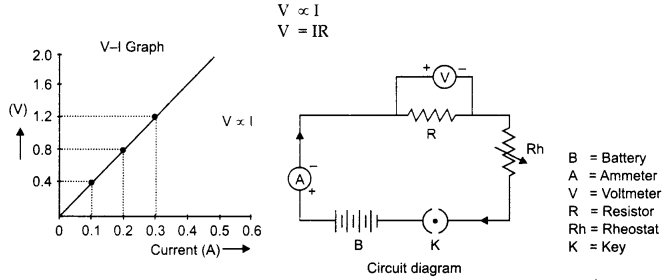
Question 2:
(a) A torch bulb is rated 2.5 V and 750 mA. Calculate
(i) its power,
(ii) its resistance,
(iii) the energy consumed if this bulb is lighted for 4 hours.
(b) Two identical resistors, each of resistance 2 Ohm, are connected in torch
(i) in series and
(ii) in parallel, to a battery of 12 volts. Calculate the ratio of power consumed in two cases.
Answer:
(a)V = 2.5V
P = ?
Energy E = ?
I =750mA = 0.75A.
R=?
t = 4hours
(i)P=VI
∴ P = 2.5 x 0.75 = 1.875W
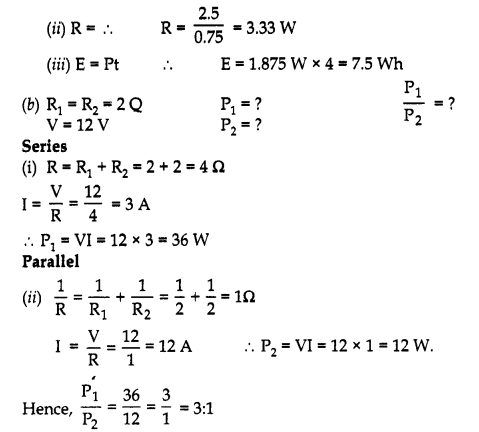
Question 3:
For the circuit shown in the diagram given below:
Calculate:
(a) the value of current through each resistor.
(b) the total current in the circuit.
(c) the total effective resistance of the circuit.
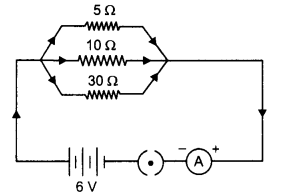
Answer:
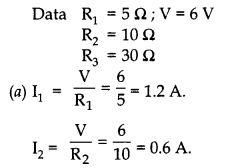
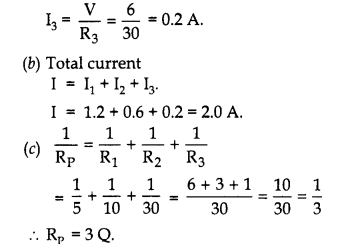
Question 4:
(a) What is meant by saying that potential difference between two points is 1 volt? Name a device that helps to measure the potential difference across a conductor.
(b) Why does the connecting cord of an electric heater not glow hot while the heating element does?
(c) Electrical resistivities of some substances at 20°C are given below:
Silver 1.6 x 10-8 Wm
Copper 1.62 x 10-8 Ωm
Tungsten 5.20 x 10-8 Ωm
Iron 10.0 x 10-8 Ωm
Mercury 94.0 x 10-8 Ωm
Nichrome 100 x 10-8 Ωm.
Answer the following questions in relation to them:
(i) Among silver and copper, which one is better conductor?
(ii) Which material would you advice to be used in electrical heating devices? Why?
Answer:
(a) Potential difference of 1 volt means the work done in carrying a unit positive charge from one point to another point is 1 Joule. Voltmeter is used to measure p.d.
(b) The heating element offers higher resistance to the flow of electrons in it and glows when the current passes through it but the cord offers extremely low resistance.
(c) (i) Silver is better conductor as its resistivity is less than copper.
(ii) Nichrome alloy can be used to make heating devices as it offers higher resistance to the flow of current so as to convert electric energy into heat energy.
Question 5:
(a) Name an instrument that measures electric current in a circuit. Define the unit of electric current.
(b) What do the following symbols mean in circuit diagram?

(c) An electric circuit consisting of a 0.5 m long nichrome wire, an ammeter, a voltmeter, four cells of 1.5 V each and a plug key was set up.
(i) Draw a diagram of the electric circuit according to given details.
(ii) Following graph was plotted between V and I values:
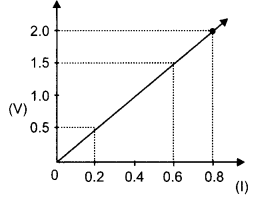
Question 6:
What would be the values of V/I ratios when the potential difference is 0.5 V, 1.5 V and 2.0 V respectively? What conclusion do you draw from these value Answer:
(a) Ammeter is used to measure electric current. S.I. unit of electric current is ampere. One ampere is defined as the current which flows in a resistor of 1Ω when 1 volt potential difference is applied across its ends.
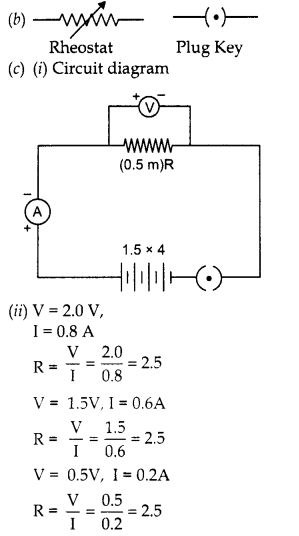
It can be concluded that ‘R’ is constant at given temperature.
Question 7:
A piece of wire of resistance 20Ω is drawn out so that its length is increased to twice its original length. Calculate the resistance of the wire in the new situation.
Answer:
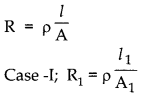
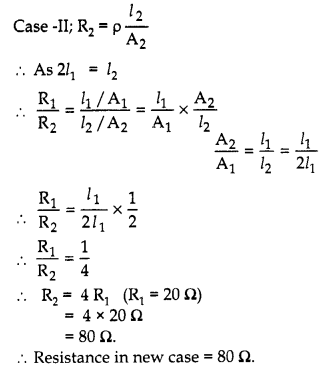
Question 8:
(a) What’is a magnetic field? State the properties of magnetic field lines.
(b) State the rule for direction of the magnetic field produced around a current carrying conductor. Draw a sketch of the pattern of field lines due to a current flowing through a straight conductor.
Answer:
(a) Magnetic Field: The region or space around a magnet where magnetic force can be experienced by other magnetic substance is called magnetic field. It is measured in tesla or weber/m2 Some properties of magnetic field lines are as follows:
- Magnetic field line goes from north pole to south pole, when outside the magnet.
- Magnetic field line goes from south pole to north pole, when inside the magnet.
- Magnetic field lines appear as concentric lines and no two lines intersect each other.
- Magnetic field lines are closer to each other when they are near the magnet but become farther from each other when they are far from the magnet.
- Closeness of field lines shows the strength of magnetic field.
(b) Right Hand Thumb Rule: Hold the wire carrying current in your right hand, such that the thumb indicates the direction of current, then the folded fingers will indicate the direction of magnetic field lines surrounding the wire.
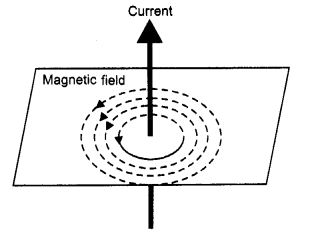
Question 9:
(a) An electric bulb is rated as 50 W, 220 V, calculate the energy consumed by the bulbs in 20 minutes. Express your answer in commercial units of electric energy.
(b) What is the difference in construction of a DC generator than that of an AC generator.
(c) Explain the woking of commutator in DC generator.
Answer:
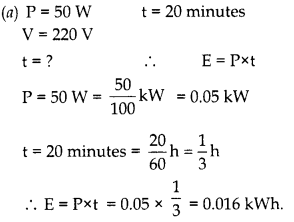
(b) The construction of DC generator is almost same as AC generator. The only difference is presence of split rings (DC Generator) in place of circular rings (AC Generator). The split ring works as commutator. The split ring is a metallic ring with two equal parts, i.e. C1 and C2. One end of armature is connected to one part of C2 while another end of armature is connected to another part of C2. The splits rings C1and C2 touch the brushes B1 and B2.
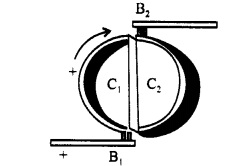
(c) Working of Commutator: When armature is rotated in the magnetic field then electric current is induced in armature. The position of brushes B: and B2 is coordinated in such a way that after every half cycle of armature, the brushes keep on changing connections from one split ring to another split ring.
This helps in maintain the current in a single direction even after each half cycle of armature.
Let us assume that in the first half cycle, the direction of current makes the ring C1 as positive terminal and C2 as negative terminal. This makes the brush B1 as positive terminal and B2 as negative terminal. In the next half cycle, direction of coil changes and C1 becomes negative while C2 becomes positive. At the same time, C1 comes in contact of B2 while C2 comes in contact of B1 Thus, B1 always remains positive and B2 always remains negative. Due to this, current always flows from B1 to B2.
We hope the given RBSE Solutions for Class 10 Science Chapter 10 Electricity Current will help you. If you have any query regarding Rajasthan Board RBSE Class 10 Science Solutions Chapter 10 Electricity Current, drop a comment below and we will get back to you at the earliest.